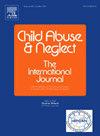调查儿童性虐待材料使用者之间的差异:来自指控和未指控个人的匿名自我报告
IF 3.4
2区 心理学
Q1 FAMILY STUDIES
引用次数: 0
摘要
暗网已经成为传播儿童性虐待材料(CSAM)的一个更为普遍的平台。大多数使用CSAM的人都没有被执法部门发现,对没有被定罪的人也知之甚少。目的本研究的目的是通过调查自述曾对儿童或成人进行性侵犯的CSAM使用者与自述未被进行性侵犯的CSAM使用者之间的差异,为CSAM使用者的研究做出贡献。参与者和设置我们分析了2384名在暗网上寻找CSAM的受访者的匿名调查数据。大多数受访者是年轻男性(18 - 34岁),他们在搜索描绘女孩的材料。样本被分为三组:1)承认曾被指控对儿童进行性侵犯的人(CS罪犯,n = 474);2)承认对成人进行性侵犯的人(AS罪犯,620人);3)不承认指控者(NC组,n = 1290)。方法采用多项logistic回归分析,分析三组患者自述行为和获取CSAM动机的差异。结果那些有暴力犯罪前科,在网上培养孩子,与孩子有过身体接触,以及搜索描绘婴幼儿的材料的人更有可能属于CS或AS罪犯组。结论:研究发现两组在个体、动机和行为特征上存在显著差异,这对调查性犯罪、评估和治疗性犯罪者具有重要意义。本文章由计算机程序翻译,如有差异,请以英文原文为准。
Investigating the disparities among child sexual abuse material users: Anonymous self-reports from both charged and uncharged individuals
Background
The dark web has become a more prevalent platform for the distribution of child sexual abuse material (CSAM). Most CSAM users remain undetected by law enforcement, and little is known about the population not convicted.
Objective
The aim of the study was to contribute to the research on CSAM users by investigating the differences between CSAM users who self-report having been charged for sexual offenses against a child or an adult and those who self-report not having been charged of such offenses.
Participants and setting
We analyzed anonymous survey data from 2384 respondents who sought CSAM on the dark web. Most of the respondents were young males (18–34-year-olds) searching for material depicting girls. The sample was divided into three groups: 1) those who admitted to having been charged for sexual offenses against children (CS offenders, n = 474); 2) those who admitted to having been charged for sexual offenses against adults (AS offenders, n = 620); and 3) those who admitted to no charges (NC group, n = 1290).
Methods
We used multinomial logistic regression analysis to analyze differences in self-reported behavior and motivation to access CSAM between the three groups.
Results
Those who had a previous history of violent offenses, had groomed children online, had physical contact with children, and searched for material depicting infants and toddlers were significantly more likely to belong to the CS or AS offenders group.
Conclusions
We found significant differences between the groups in their individual, motivational, and behavioral characteristics that have important implications for investigating sexual crimes and assessing and treating sexual offenders.
求助全文
通过发布文献求助,成功后即可免费获取论文全文。
去求助
来源期刊

Child Abuse & Neglect
Multiple-
CiteScore
7.40
自引率
10.40%
发文量
397
期刊介绍:
Official Publication of the International Society for Prevention of Child Abuse and Neglect. Child Abuse & Neglect The International Journal, provides an international, multidisciplinary forum on all aspects of child abuse and neglect, with special emphasis on prevention and treatment; the scope extends further to all those aspects of life which either favor or hinder child development. While contributions will primarily be from the fields of psychology, psychiatry, social work, medicine, nursing, law enforcement, legislature, education, and anthropology, the Journal encourages the concerned lay individual and child-oriented advocate organizations to contribute.
 求助内容:
求助内容: 应助结果提醒方式:
应助结果提醒方式:


